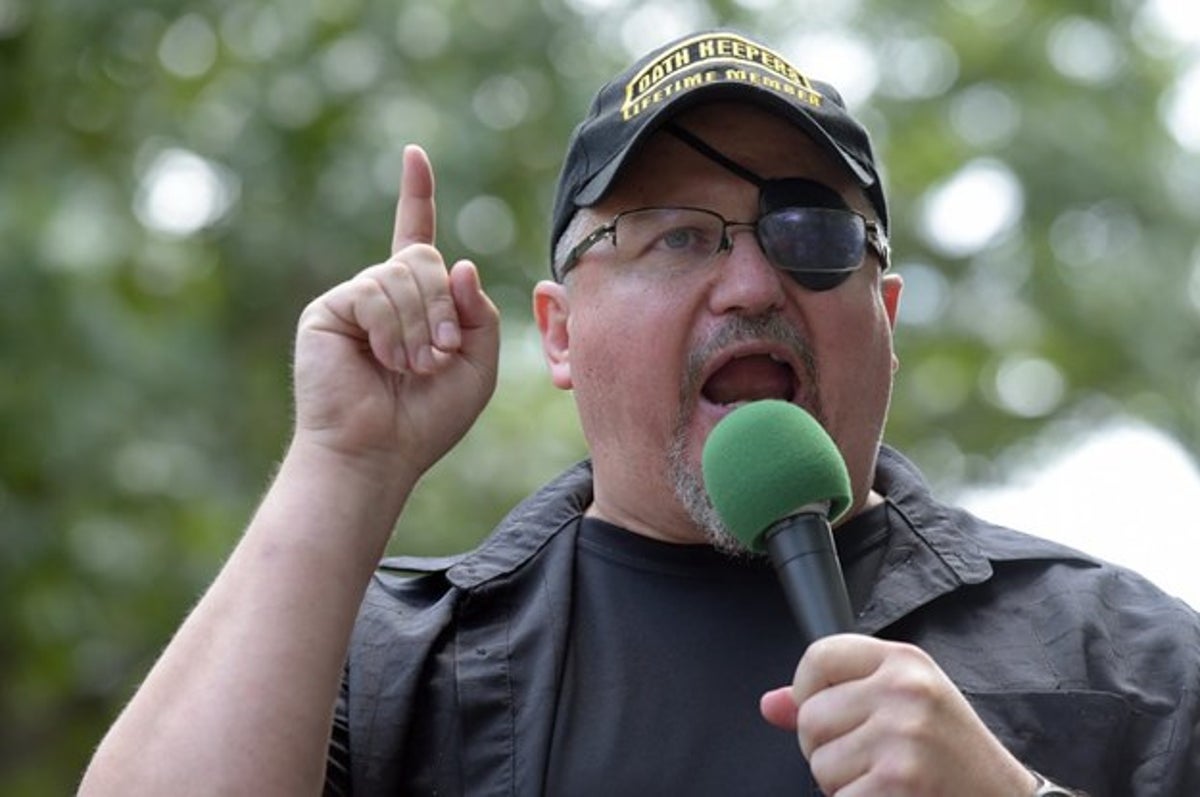Federal prosecutors on Monday claimed that the leader of the Oath Keepers encouraged his followers to come to Washington, DC, on January 6 armed with non-lethal weapons and then stay outside the Capitol during the insurrection, directing them to a potential entry point.
Shortly after 2 pm on January 6, according to prosecutors in a new lawsuit, Stewart Rhodes sent a message on the encrypted Signal app to several of his followers saying, “Come to the south side of the Capitol on the stairs.” At 2:41 pm, Rhodes, who is referred to in court cases as Person One, posted a photograph of the Capitol with the caption: “South side of the US Capitol. Patriots knocking on doors. “
Monday’s lawsuit is the clearest indication that federal prosecutors have ever given that they believe Rhodes played a significant role in real-time actions on 6 January. Prosecutors have already accused several Oath Keepers of conspiracy for their actions on Capitol Hill and described the Oath Keepers as a “loosely organized collection of militias who believe the federal government was co-opted by an obscure conspiracy that is trying to deprive American citizens of their rights” .
Rhodes, who started the group in 2009, did not immediately respond to requests for comment. Interviewed by Alex Jones for Infowars in late January, Rhodes denied having played any role in the attack on the Capitol. He was not charged.
Although prosecutors referred to Rhodes by name in prosecution documents filed against Thomas Caldwell and two others arrested in mid-January, they began to refer to him as Person One in subsequent cases. In a January 27 lawsuit, prosecutors wrote: “The Oath Keepers are led by Person One.” Prosecutors also cite Rhodes’ public statements in their records and attribute them to Person One.
Details about Rhodes’ Signal’s messages on the day of the Capitol attack came as the Justice Department argued for the continued detention of Caldwell, a retired 67-year-old Navy officer from Virginia. Caldwell, who is not a fee-paying member of the Oath Keepers, was with them on Capitol that day and involved in their planning, including booking hotel rooms, according to the filing.
In the messages, prosecutors said, Rhodes communicated with other Oath Keepers ahead of the day’s events, informing them that the group would have “several well-equipped QRFs outside of DC”, using an acronym for Rapid Reaction Force – heavily armed teams prepared to jump into battle.
Prosecutors previously claimed that Oath Keepers, including Caldwell, discussed QRFs and made plans to use trucks or boats to transport weapons to the District of Columbia on January 6. At the end of last month, the government told a federal judge that it had a “job understanding”That the Oath Keepers had a QRF parked outside of DC that day.
In group messages quoted on Monday, Rhodes advised his fellow Oath Keepers to avoid bringing items into the city that could cause them to be arrested, such as weapons; he suggested that they wear eye protection, helmets and “good hard gloves” and carry heavy flashlights that apparently could be used as clubs, according to the documents. Rhodes added that he intended to carry a folding stick because they “are a gray area of the law”, noting that “I am willing to take that risk because I love them”.
A grand jury has so far indicted nine people described as Oath Keepers for crimes related to the January 6 uprising; on Saturday, a New York tattoo artist that Rhodes designated last year as “lifelong Oath Keeper” was also arrested and charged.
Rhodes has repeatedly said in interviews and on social media that he thought the 2020 election was not legitimate and that Donald Trump should not resign from the presidency. In their lawsuit on Monday, prosecutors showed texts sent by Rhodes expressing frustration that not enough was being done to prevent Congressional certification of the Electoral College.
According to prosecutors, at 1:38 pm on January 6, just after then President Donald Trump finished his speech and the protesters started fighting with the police outside the Capitol, Rhodes wrote in the group chat: “Everything what I see Trump doing is complaining. I don’t see his intention to do anything. Therefore, patriots are taking justice into their own hands. They’ve had enough. “
Just a few hours later, around 4 pm, when protesters started to leave the Capitol, a large group of Oath Keepers “met” in Rhodes on the east side of the building and “waited for at least ten minutes at that location”, the Monday lawsuit said.
Caldwell was arrested on January 19 and has been in detention ever since. He argued that he never entered the Capitol, that he is physically disabled to take an active role in the riots, that he is not in favor of violence and that he is not a paying lawyer.
Last month, a federal judge denied his bail request, saying he “was not only a danger to the community, but to the fabric of democracy”. Caldwell subsequently changed lawyers and last week asked the court to reconsider his release, claiming that the charges against him were “riddled with inaccuracies”.
Monday’s filing by prosecutors responded to those arguments, citing messages sent by Caldwell as evidence that he “plays a leadership role within the Oath Keepers” and was deeply involved in planning and preparing for January 6. about his role in invading the Capitol.
“I took my American flag and said, ‘Let’s get the damn capitol,'” says a text message sent by Caldwell, cited by the Department of Justice. “So people started to move forward and climb the scaffolding outside, so I said, let’s invade the place and hang the traitors.”
Caldwell later sent another text message, prosecutors said: “If we had guns, I guarantee that we would have killed 100 politicians. They fled and were taken away by their underground tunnels like the rats they were. “
